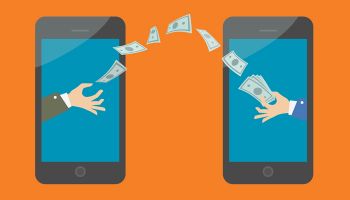Consumer payment in a flash
U.S. Bank, BofA are first clearXchange members to go live with real-time payments
- |
- Written by Kathie Beans, freelance writer

Two of the seven large banks that own the clearXchange network have gone live with the network’s new real-time payment capability. The nearly 22 million mobile banking customers of U.S. Bank and BofA can now use their smartphones to send real-time P2P payments to customers at either bank. The payments go directly into the recipients bank accounts. No sensitive account information is shared.
The other five banks in the network—JPMorgan Chase, Capital One, Wells Fargo, BB&T, and PNC—are expected to roll out the smartphone-based person-to-person (P2P) mobile product by this summer. Eventually all U.S. banks and credit unions will be able to use clearXchange to offer customers instant P2P mobile payments.
Gareth Gaston, executive vice-president of omnichannel banking at U.S. Bank, says the real-time payment product is “compelling” and will grow in popularity because customers trust their banks. There is no intermediary, and the payment process is seamless and secure, says Gaston.
“Banks are making it a very easy customer experience,” Gaston explains. “This is about sending money between bank accounts. Friends and family can pay each other immediately even if they don’t use the same bank.”
Thong Nguyen, president of retail banking at Bank of America, says, “We’re focused on creating a simple, straightforward person-to-person payments experience that lets our customers pay anyone with a couple of easy, intuitive steps.”
Understanding how it works
Real-time P2P payments are processed in two steps. First, after enrolling in their bank’s money transfer program, a customer initiates a P2P payment through online or mobile banking channels using a qualified recipient’s email address or mobile number. Second, a payment notification is sent to the recipient and funds are made available for withdrawal using any channel, including in the branch, at the ATM, with a debit card, or at a point of sale.
With no third party involved, clearXchange enables bank customers to make P2P payments directly from their existing deposit account through their bank's online and mobile platforms. When receiving a payment, funds are directly deposited into the customer's bank account.
Keeping bank hands on the wheel
P2P payments are popular, especially with millennials who already use nonbanks such as PayPal’s Venmo to make small payments to each other for dinner, rent, or tickets to shows or sporting events tickets. The nonbanks, however, are intermediaries, and do not offer real-time payment.
Gaston says the clearXchange mobile payments product was developed because customers expect their banks to provide an electronic means to send money to each other.
“Our goal is to provide a competent and competitive product that is integrated into customers’ banking experience—and to do it in real time,” says Gaston. “We don’t want our customers to go elsewhere.”
To receive P2P mobile payments, customers of clearXchange member banks just need to select which phone number or email address they want to use to receive money. Those whose banks are not yet part of the network must complete a one-time online registration at clearxchange.com and provide their email address and mobile number.
At U.S. Bank transaction fees are $6.95 for real-time or instant payments and $2.95 for next-day payments. There is no charge for standard delivery payments or for emails to request money.
A spokesperson for BofA said the bank does not charge a fee for real-time payments through the clearXchange network.
Looking back at origins
In October 2015, the CEOs of U.S. Bank and other consortium members announced they were combining clearXchange with Early Warning, a fraud, risk, and authentication service also owned by the banks. Using a data exchange system based on collaborative, shared intelligence, Early Warning provides risk management solutions to a network of 2,300 financial institutions, government entities, and payment companies.
The CEOs said the combined, enhanced platform would help modernize and secure the U.S. payment system as envisioned by the Federal Reserve Bank’s Payment System Improvement Initiative. They also indicated that the platform’s capabilities would meet the Consumer Financial Protection Bureau’s vision of consumer protection in new faster payment systems.
Formed in 2011, the clearXchange network is the largest bank-offered digital payments network in the U.S. Gaston predicts that as other banks join clearXchange, “real-time payments will be ubiquitous within the industry and become the norm. This is an exciting time in the industry for banks and our customers.”













